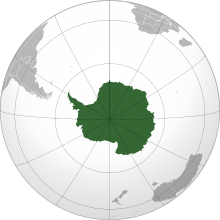Our website is made possible by displaying online advertisements to our visitors.
Please consider supporting us by disabling your ad blocker.
Antarctica
 | |
| Area |
|
|---|---|
| Population | At Least 77 (about 1000 people living temporarily) |
| Dependencies | |
| Time zones | None |
| Internet TLD | .aq |
Antarctica is the Earth's southernmost and the continent with the least people. It is on the South Pole. It is almost entirely south of the Antarctic Circle. Around Antarctica is the Southern Ocean. It is the fifth-largest continent in area after Asia, Africa, North America, and South America.[2] About 99% of Antarctica is covered by ice. This ice averages at least 1.6 kilometers (1.0 miles) thick.
Antarctica is the coldest, driest and windiest continent. It is also, on average, the highest of all the continents.[3] Antarctica is considered a desert.[4] It is the largest and coldest desert in the world.[5] It has yearly precipitation of only 200 mm (8 inches) near the sea and far less inland.[6] No humans live in Antarctica permanently. However, about 1,000 to 5,000 people live through the year at the science stations in Antarctica. Only plants and animals that can live in cold live there. The animals include penguins, seals, nematodes, tardigrades and mites. Plant life includes some grass and shrubs, algae, lichen, fungi, and bacteria.
The first known polar sighting of the continent was in 1820. Antarctica was mostly forgotten for the rest of the 19th century. This was because of its incredibly hostile environment, few resources, and isolation. The first official use of the name Antarctica as a continental name in the 1890s is said to have been used by Scottish cartographer John George Bartholomew.
The Antarctic Treaty was signed in 1959 by 21 countries. More countries have signed the treaty since then. So far, 46 countries have signed the treaty. The treaty declares that military activities and mineral mining are against the law. However, it supports scientific research. It also helps the continent's ozone. More than 4,000 scientists from different nations and different interests experiment together.[1]

- ↑ 1.0 1.1 "Antarctica - The World Factbook". United States Central Intelligence Agency. 2007-03-08. Archived from the original on 2018-12-25. Retrieved 2007-03-14.
- ↑ 14.0 million km2 5.4 million sq mi,
- ↑ "National Geophysical Data Center". National Satellite, Data, and Information Service. Archived from the original on 15 June 2006. Retrieved 9 June 2006. Choose the South Pole view.
- ↑ Campbell I.B. and Claridge G.G.C. 1987. Antarctia:soils, weathering, processes and environment p4 Elsevier, Amsterdam, Netherlands. ISBN 0-444-42784-8
- ↑ "Not all Deserts are Sandy". National Geographic Society. Retrieved 25 February 2024.
- ↑ C. Alan Joyce (2007-01-18). "The World at a glance: surprising facts". The World Almanac. Archived from the original on 2009-03-04. Retrieved 2009-02-07.
Previous Page Next Page






